In the realm of aviation, piston aircraft stand as enduring icons of flight, embodying a rich history and a timeless allure. These aircraft, propelled by piston engines, have played pivotal roles in aviation development, from early pioneering flights to modern recreational and utility use. In this guide, we delve into the essence of piston aircraft, exploring their design, operation, and significance in the aviation landscape.
The Basics of Piston Aircraft
Piston aircraft, also known as reciprocating-engine aircraft, rely on internal combustion engines to generate thrust and propel them through the air. Unlike jet aircraft, which utilize gas turbines, piston aircraft engines operate by burning fuel in enclosed cylinders to drive a crankshaft, which in turn spins the propeller.
Components of a Piston Aircraft
A typical piston aircraft consists of several key components:
- Engine: The heart of the aircraft, the engine powers the propeller and provides thrust.
- Propeller: Mounted at the front of the aircraft, the propeller converts engine power into thrust by spinning rapidly.
- Fuselage: The main body of the aircraft, housing the cockpit, cabin, and cargo areas.
- Wings: Generate lift to keep the aircraft aloft, typically attached to the fuselage.
- Landing Gear: Wheels or skids that enable takeoff, landing, and ground movement.
Types of Piston Aircraft
Piston aircraft come in various configurations suited to different purposes:
Single-Engine Piston Aircraft
Often used for training and personal transportation, single-engine piston aircraft are characterized by their simplicity and affordability. They typically seat fewer passengers and have shorter range compared to multi-engine counterparts.
Multi-Engine Piston Aircraft
Designed for increased performance and redundancy, multi-engine piston aircraft feature two or more piston engines. They offer higher speeds, greater payload capacity, and enhanced safety through redundancy.
Applications of Piston Aircraft
Piston aircraft find utility across a diverse range of applications:
Training
Single-engine piston aircraft are widely used for pilot training due to their simplicity and cost-effectiveness. They provide aspiring pilots with the foundational skills necessary for more advanced aircraft.
Personal and Business Travel
For short to medium-range trips, piston aircraft offer a convenient and flexible mode of transportation. Business executives and private individuals often utilize piston aircraft to access remote locations efficiently.
Agricultural Operations
Piston-powered agricultural aircraft, such as crop dusters, play a crucial role in aerial application, including crop spraying and pest control. Their maneuverability and low operating costs make them ideal for agricultural tasks.
The Future of Piston Aircraft
While piston aircraft continue to serve vital roles in aviation, technological advancements and evolving market demands are shaping their future. Innovations in engine efficiency, materials, and avionics are enhancing performance and sustainability.
Electric Propulsion
Emerging electric propulsion technologies hold promise for reducing emissions and operating costs in piston aircraft. Electrically powered propulsion systems offer quieter operation and lower environmental impact compared to traditional combustion engines.
Advanced Avionics
Integration of advanced avionics systems, including glass cockpits and digital flight controls, is enhancing safety and situational awareness in piston aircraft. These technologies improve pilot decision-making and reduce the workload associated with flight operations.
As piston aircraft continue to evolve, they remain an integral part of the aviation landscape, blending tradition with innovation to meet the diverse needs of pilots and operators worldwide.
Frequently Asked Questions
Here are some common questions about piston aircraft:
| Question | Answer |
|---|---|
| 1. How do piston aircraft differ from jet aircraft? | Piston aircraft use internal combustion engines to drive a propeller for propulsion, while jet aircraft use gas turbines. |
| 2. What are the main applications of piston aircraft? | Piston aircraft are used for training, personal and business travel, as well as agricultural operations such as crop spraying. |
| 3. What advantages do multi-engine piston aircraft offer? | Multi-engine piston aircraft provide increased performance, higher payload capacity, and enhanced safety through redundancy. |
| 4. How are technological advancements influencing the future of piston aircraft? | Technological advancements such as electric propulsion and advanced avionics are enhancing the efficiency, sustainability, and safety of piston aircraft. |
Environmental Impact
One aspect of piston aircraft that often concerns people is their environmental impact. While piston engines are more fuel-efficient than jet engines at lower altitudes and speeds, they still emit pollutants. However, advancements in electric propulsion aim to address these concerns by providing cleaner and more sustainable alternatives.
Recreational Use
Besides their practical applications, piston aircraft are also widely used for recreational flying. Many aviation enthusiasts and hobbyists own or rent piston aircraft for leisurely flights, sightseeing tours, and aerial photography.
Maintenance Considerations
Like any aircraft, piston aircraft require regular maintenance to ensure safe and reliable operation. Owners and operators must adhere to maintenance schedules outlined by regulatory authorities and manufacturers to keep their aircraft in airworthy condition.






